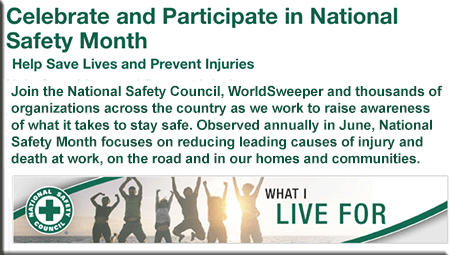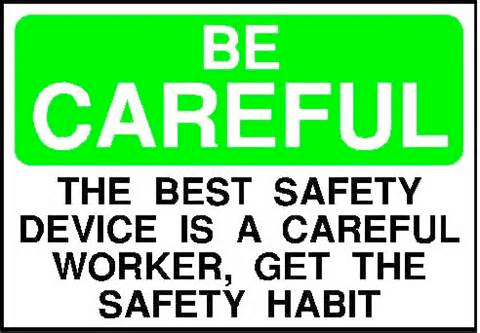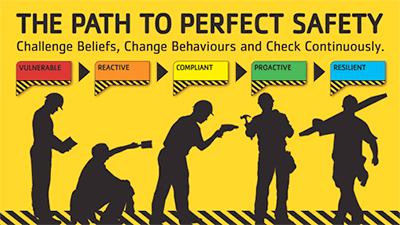Safety Tips for Sweeping Professionals |
How to Create a 'Culture of Safety' in Your Organization
Axiom #1: The most important part of your Safety Program is the part that combines the employee and the job at hand... SAFELY.
by John Meola, CSP, ARM, Pillar Engineers, Inc.  Experience has shown the predominant perceptions of occupational safety by managers of most small- to mid-size companies – as well as that of some municipal entities – are best summarized by the name of a major river in Africa.
Experience has shown the predominant perceptions of occupational safety by managers of most small- to mid-size companies – as well as that of some municipal entities – are best summarized by the name of a major river in Africa.
The fact that you are reading this article shows your interest in establishing the key elements necessary for keeping the jobs under your control running smoothly, as well as incident- and injury-free. Here are the basics for how to accomplish that: The Number One Basic Action: Tell your staff, your people, and your supervisors: "I want you to work safely. I do not want you to get hurt." The above may sound simplistic, but it is, in fact, the basic first step in acknowledging that your organization has an ongoing, never-ending safety problem and challenge. It's kind of like a reforming alcoholic: We know that our behavior needs correcting, so we need to make the admission and then get help. You have now moved past the "De Nile" stage. Step #2: "Now what?"Achieving a basic level of compliance is relatively easy. The Occupational Safety and Health Administration (OSHA) spells out the steps in their voluminous information. However, your own unique Safety Program will be based largely on a number of technical details that correspond to the work you do. The fact is, though, that most everyone reading this, whether a sweeping contractor or a public works' professional, will be operating a business that includes exposure and safety issues that are more complex than most. These types of businesses typically involve what safety professionals call "increased exposure." Classic high-exposure categories include driving vehicles of any type, work at heights, confined spaces, high-energy sources, chemicals and hazardous substances, and strenuous manual labor. Probably most of these sound familiar to what your employees do, right?! Because these risk exposures can easily cause something very bad to happen to your employee(s), you already pay more for your insurance even if you've had no claims ever. And, having good insurance helps ease management's anxiety to a degree. But, without a strong safety program, you won't be able to sleep at night if you're wondering if you and your people are properly protected. Enter: The Supervisor – the person on the ground who is going to organize and lead the crew, protect the operation and, at the same time, actually try to get some work done. Most supervisors have a fairly good technical skill level for what it takes to do the jobs done by their employees. They wouldn't have been promoted to that position if they didn't. And, they're probably safety conscious as well. What will give everyone the best night's sleep is the knowledge that your supervisor(s) are actually leading the crew in a way that exemplifies your concern for safety and getting the work done. Let's face it, we all take shortcuts. We'll always be on the lookout for 'efficiencies' in any process. And, even with great initial training, any change in the process is something that can impact the safety factors of the process. This is how we improve over time. However, we need to recognize there must be limits to shortcutting the 'tried-and-true' processes, particularly when it comes to shortcuts that might negatively impact safety. Your supervisor needs to know what these limits are before taking a shortcut or allowing others to take them. Some shortcuts are also defined with "The L Word" (Laziness). The problem is, you're back at the office and your crews are on the job. Oftentimes, an owner or supervisor is not there to control what is occurring out where the action is, on the jobsite. The most effective restraint against 'safety blowoff' on the job is called 'Your Established Safety Culture.' This is the ingrained understanding that certain (SAFE) behavior is expected, and that other certain (UNSAFE) behavior will not be tolerated. All supervisors and employees need to know which is which. (This should have been part of their safety training up in Step 2.) 
So, here's how your people actually learn about your company's Safety Culture:

The fact is, the programs and principles about safety are all your people are going to actually 'see.' They are not going to read your safety wallpaper manual. They are also not going to be the ones who end up sitting down with your accountant to figure out what happened that made your insurance bill go through the roof or why you got stuck in the high-risk pool because of your lousy accident experience. All of that is your problem. (So is notifying next of kin about what happened to their loved one while they were on the job working for you...) What the employee sees is extremely important: that you bought heavier grade ladders to replace the ones that wore out; that they can actually see through their safety glasses because the Safety Committee recommended you buy the scratch-resistant, coated lenses, etc. Even if you do some of the above, you're ahead of the curve. If you actually plan on being in business for the next five or 10 years, I suggest that you enroll your high-potential supervisors into formal education classes (i.e., community college and/or tech school) in classes like business communications, leadership and coaching, occupational safety, introduction to industrial psychology, human resources development, and other subjects that are designed to increase knowledge about employee management, including safety. In summary, safety is like any other business management function – only it's personal. However, you're dealing with people instead of machine tools. You will learn that the simplest, most visible actions speak louder than a bookcase full of paper. You just read almost 1,500 words in order to teach you to convey ONE word to your people: SAFETY! If you find any easier ways to develop a culture of safety with your personnel, be sure to let me know. John J. Meola, the safety director at Pillar Engineers, Inc., is a Certified Safety Professional and adjunct instructor in Occupational Safety at Virginia Commonwealth University in Richmond, Virginia. He has over 25 years of hands-on safety leadership and management experience in construction and industry, and he has published two safety handbooks and numerous technical articles in trade industry publications. John may be reached via email.
|
© 2005 - 2021 All rights reserved. |
Back to Safety Tips Table of ContentsSite Map / Table of ContentsSite Map / Table of Contents |